BO1BSRE301 - Advertising Industry Analysis: A Business Strategy Case
VerifiedAdded on 2023/06/15
|7
|1470
|121
Case Study
AI Summary
This case study provides a comprehensive analysis of the advertising industry using the PESTEL framework and Porter's Five Forces model. The PESTEL analysis covers demographic, political, legal, economic, social, technological, and environmental factors influencing the industry. The Porter's Five Forces analysis evaluates the threat of new entrants, power of suppliers, power of buyers, threat of substitute products, and the intensity of rivalry within the advertising sector. The analysis aims to provide a strategic overview of the advertising industry's competitive landscape and key success factors.
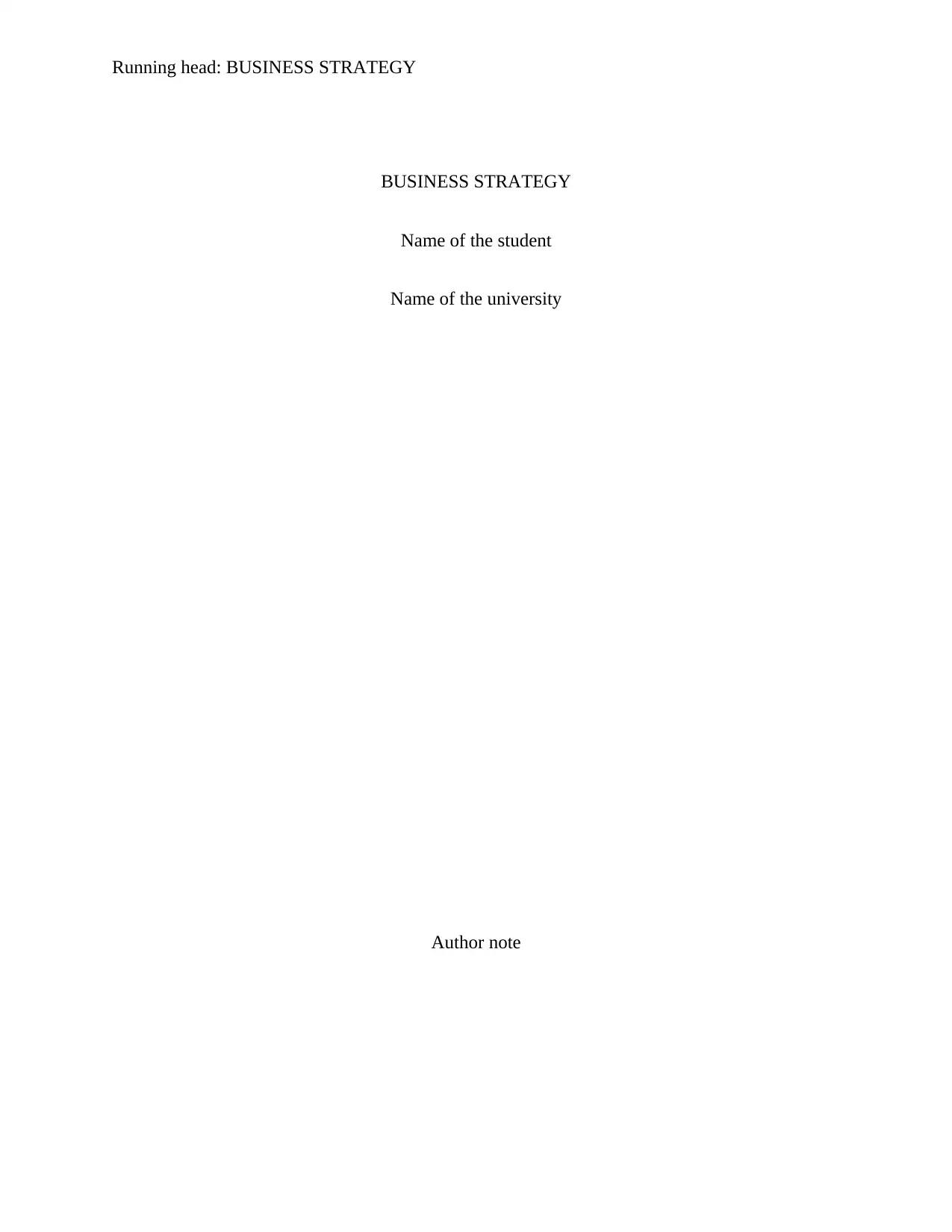
Running head: BUSINESS STRATEGY
BUSINESS STRATEGY
Name of the student
Name of the university
Author note
BUSINESS STRATEGY
Name of the student
Name of the university
Author note
Paraphrase This Document
Need a fresh take? Get an instant paraphrase of this document with our AI Paraphraser
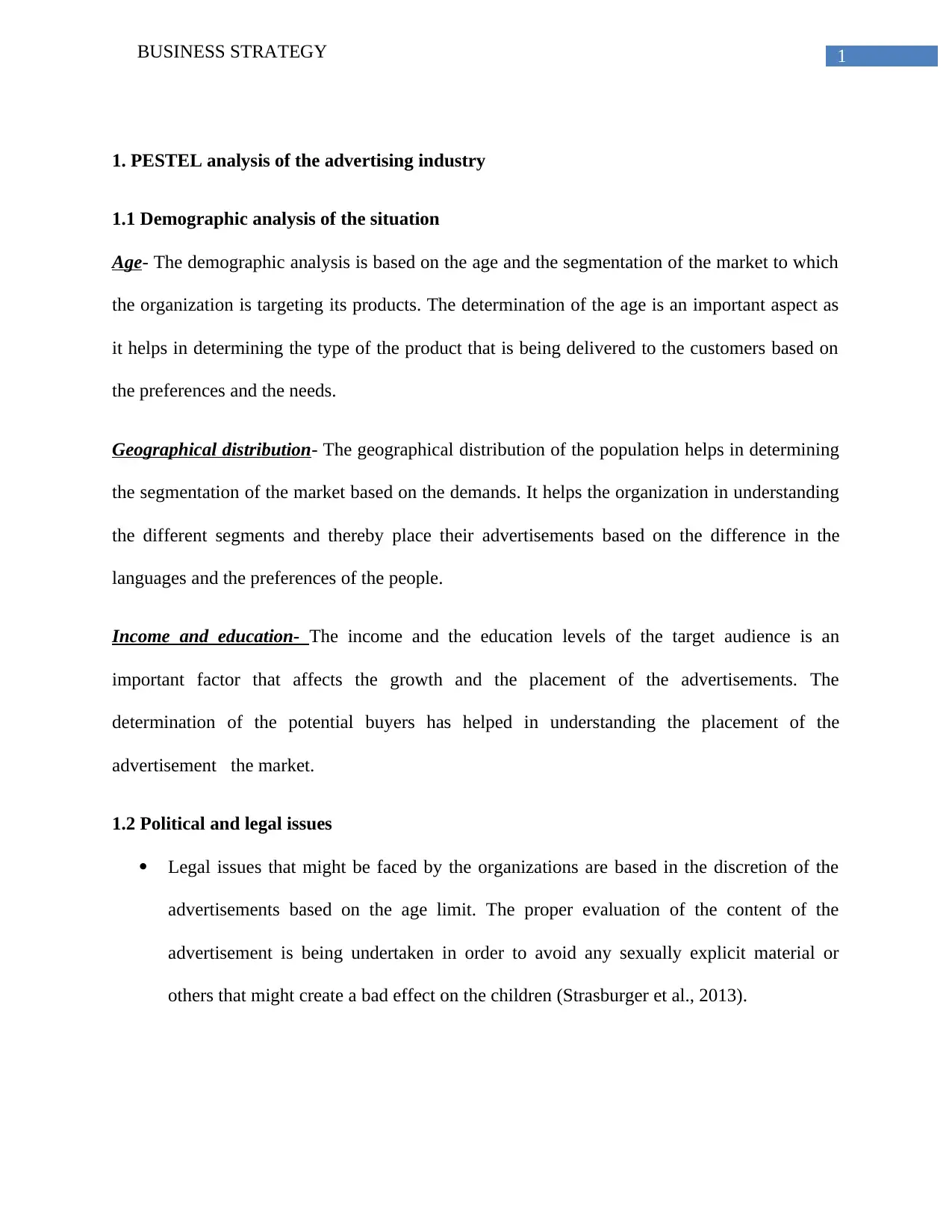
1BUSINESS STRATEGY
1. PESTEL analysis of the advertising industry
1.1 Demographic analysis of the situation
Age- The demographic analysis is based on the age and the segmentation of the market to which
the organization is targeting its products. The determination of the age is an important aspect as
it helps in determining the type of the product that is being delivered to the customers based on
the preferences and the needs.
Geographical distribution- The geographical distribution of the population helps in determining
the segmentation of the market based on the demands. It helps the organization in understanding
the different segments and thereby place their advertisements based on the difference in the
languages and the preferences of the people.
Income and education- The income and the education levels of the target audience is an
important factor that affects the growth and the placement of the advertisements. The
determination of the potential buyers has helped in understanding the placement of the
advertisement the market.
1.2 Political and legal issues
Legal issues that might be faced by the organizations are based in the discretion of the
advertisements based on the age limit. The proper evaluation of the content of the
advertisement is being undertaken in order to avoid any sexually explicit material or
others that might create a bad effect on the children (Strasburger et al., 2013).
1. PESTEL analysis of the advertising industry
1.1 Demographic analysis of the situation
Age- The demographic analysis is based on the age and the segmentation of the market to which
the organization is targeting its products. The determination of the age is an important aspect as
it helps in determining the type of the product that is being delivered to the customers based on
the preferences and the needs.
Geographical distribution- The geographical distribution of the population helps in determining
the segmentation of the market based on the demands. It helps the organization in understanding
the different segments and thereby place their advertisements based on the difference in the
languages and the preferences of the people.
Income and education- The income and the education levels of the target audience is an
important factor that affects the growth and the placement of the advertisements. The
determination of the potential buyers has helped in understanding the placement of the
advertisement the market.
1.2 Political and legal issues
Legal issues that might be faced by the organizations are based in the discretion of the
advertisements based on the age limit. The proper evaluation of the content of the
advertisement is being undertaken in order to avoid any sexually explicit material or
others that might create a bad effect on the children (Strasburger et al., 2013).
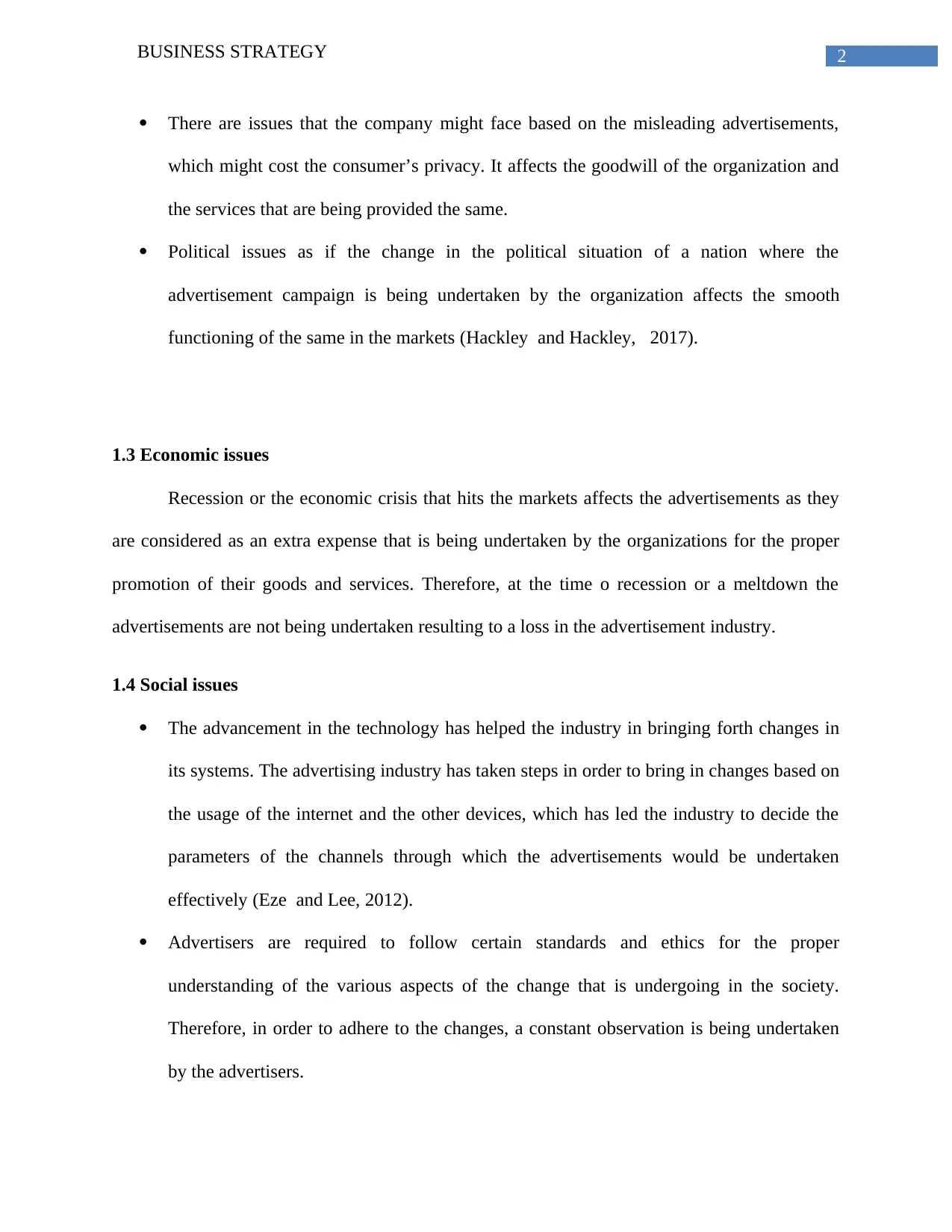
2BUSINESS STRATEGY
There are issues that the company might face based on the misleading advertisements,
which might cost the consumer’s privacy. It affects the goodwill of the organization and
the services that are being provided the same.
Political issues as if the change in the political situation of a nation where the
advertisement campaign is being undertaken by the organization affects the smooth
functioning of the same in the markets (Hackley and Hackley, 2017).
1.3 Economic issues
Recession or the economic crisis that hits the markets affects the advertisements as they
are considered as an extra expense that is being undertaken by the organizations for the proper
promotion of their goods and services. Therefore, at the time o recession or a meltdown the
advertisements are not being undertaken resulting to a loss in the advertisement industry.
1.4 Social issues
The advancement in the technology has helped the industry in bringing forth changes in
its systems. The advertising industry has taken steps in order to bring in changes based on
the usage of the internet and the other devices, which has led the industry to decide the
parameters of the channels through which the advertisements would be undertaken
effectively (Eze and Lee, 2012).
Advertisers are required to follow certain standards and ethics for the proper
understanding of the various aspects of the change that is undergoing in the society.
Therefore, in order to adhere to the changes, a constant observation is being undertaken
by the advertisers.
There are issues that the company might face based on the misleading advertisements,
which might cost the consumer’s privacy. It affects the goodwill of the organization and
the services that are being provided the same.
Political issues as if the change in the political situation of a nation where the
advertisement campaign is being undertaken by the organization affects the smooth
functioning of the same in the markets (Hackley and Hackley, 2017).
1.3 Economic issues
Recession or the economic crisis that hits the markets affects the advertisements as they
are considered as an extra expense that is being undertaken by the organizations for the proper
promotion of their goods and services. Therefore, at the time o recession or a meltdown the
advertisements are not being undertaken resulting to a loss in the advertisement industry.
1.4 Social issues
The advancement in the technology has helped the industry in bringing forth changes in
its systems. The advertising industry has taken steps in order to bring in changes based on
the usage of the internet and the other devices, which has led the industry to decide the
parameters of the channels through which the advertisements would be undertaken
effectively (Eze and Lee, 2012).
Advertisers are required to follow certain standards and ethics for the proper
understanding of the various aspects of the change that is undergoing in the society.
Therefore, in order to adhere to the changes, a constant observation is being undertaken
by the advertisers.
⊘ This is a preview!⊘
Do you want full access?
Subscribe today to unlock all pages.

Trusted by 1+ million students worldwide
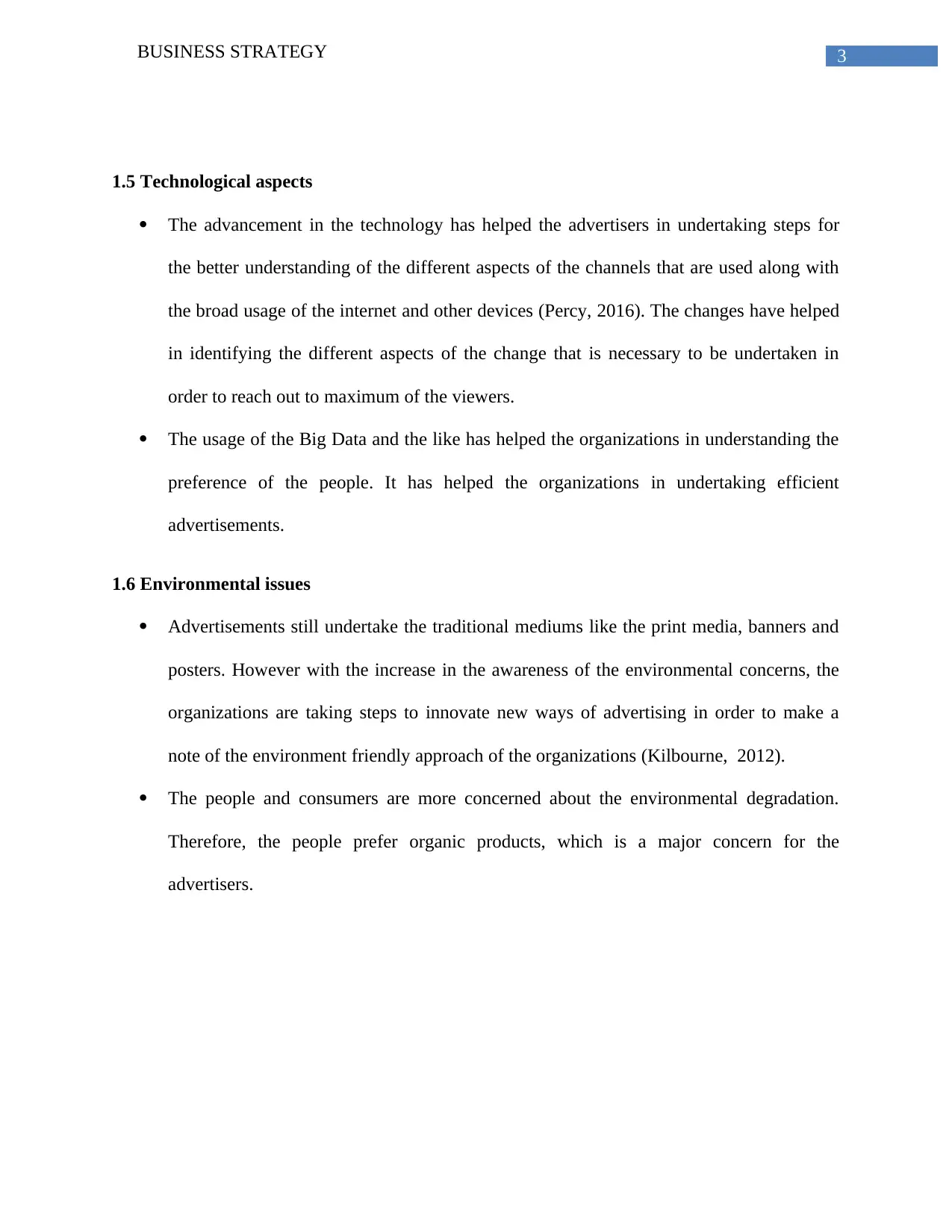
3BUSINESS STRATEGY
1.5 Technological aspects
The advancement in the technology has helped the advertisers in undertaking steps for
the better understanding of the different aspects of the channels that are used along with
the broad usage of the internet and other devices (Percy, 2016). The changes have helped
in identifying the different aspects of the change that is necessary to be undertaken in
order to reach out to maximum of the viewers.
The usage of the Big Data and the like has helped the organizations in understanding the
preference of the people. It has helped the organizations in undertaking efficient
advertisements.
1.6 Environmental issues
Advertisements still undertake the traditional mediums like the print media, banners and
posters. However with the increase in the awareness of the environmental concerns, the
organizations are taking steps to innovate new ways of advertising in order to make a
note of the environment friendly approach of the organizations (Kilbourne, 2012).
The people and consumers are more concerned about the environmental degradation.
Therefore, the people prefer organic products, which is a major concern for the
advertisers.
1.5 Technological aspects
The advancement in the technology has helped the advertisers in undertaking steps for
the better understanding of the different aspects of the channels that are used along with
the broad usage of the internet and other devices (Percy, 2016). The changes have helped
in identifying the different aspects of the change that is necessary to be undertaken in
order to reach out to maximum of the viewers.
The usage of the Big Data and the like has helped the organizations in understanding the
preference of the people. It has helped the organizations in undertaking efficient
advertisements.
1.6 Environmental issues
Advertisements still undertake the traditional mediums like the print media, banners and
posters. However with the increase in the awareness of the environmental concerns, the
organizations are taking steps to innovate new ways of advertising in order to make a
note of the environment friendly approach of the organizations (Kilbourne, 2012).
The people and consumers are more concerned about the environmental degradation.
Therefore, the people prefer organic products, which is a major concern for the
advertisers.
Paraphrase This Document
Need a fresh take? Get an instant paraphrase of this document with our AI Paraphraser
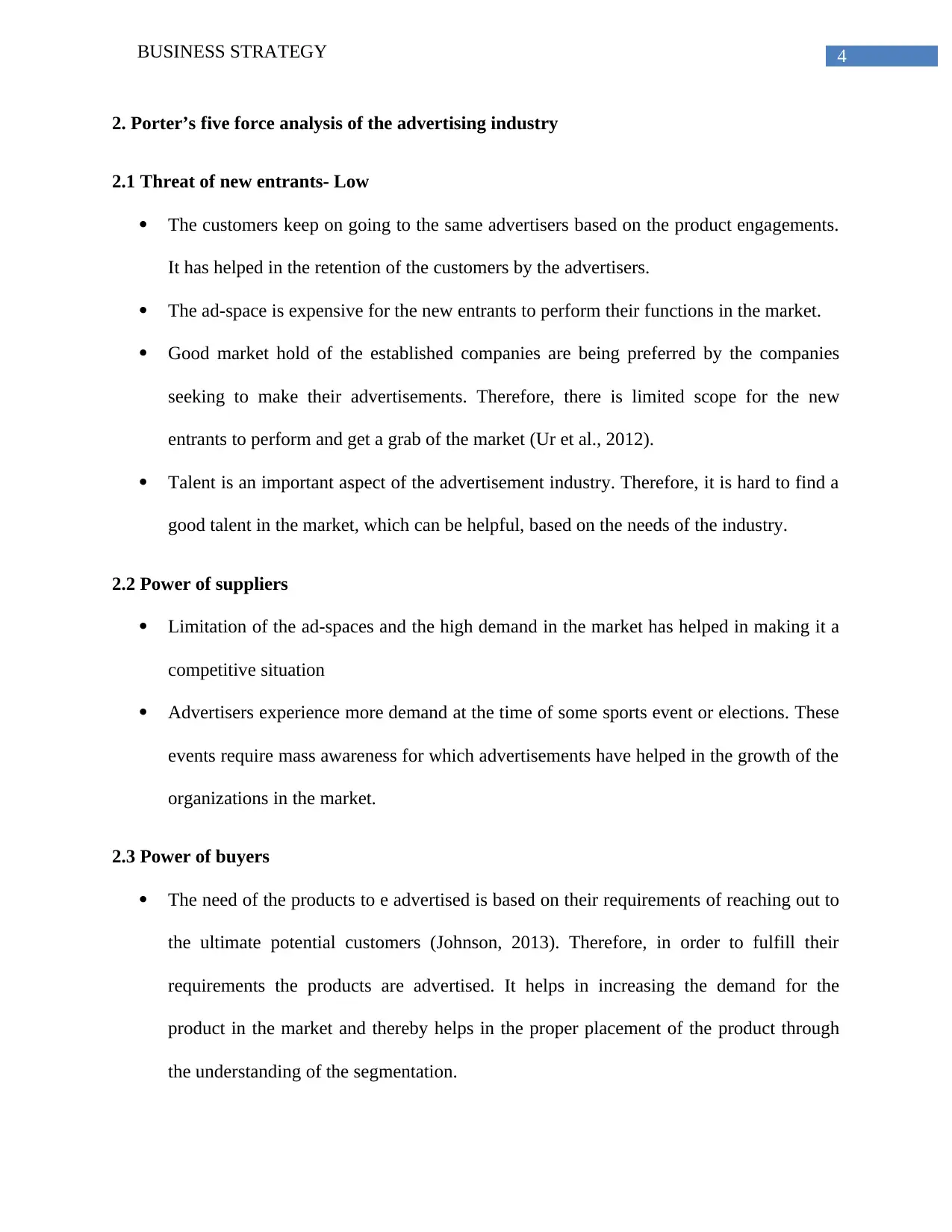
4BUSINESS STRATEGY
2. Porter’s five force analysis of the advertising industry
2.1 Threat of new entrants- Low
The customers keep on going to the same advertisers based on the product engagements.
It has helped in the retention of the customers by the advertisers.
The ad-space is expensive for the new entrants to perform their functions in the market.
Good market hold of the established companies are being preferred by the companies
seeking to make their advertisements. Therefore, there is limited scope for the new
entrants to perform and get a grab of the market (Ur et al., 2012).
Talent is an important aspect of the advertisement industry. Therefore, it is hard to find a
good talent in the market, which can be helpful, based on the needs of the industry.
2.2 Power of suppliers
Limitation of the ad-spaces and the high demand in the market has helped in making it a
competitive situation
Advertisers experience more demand at the time of some sports event or elections. These
events require mass awareness for which advertisements have helped in the growth of the
organizations in the market.
2.3 Power of buyers
The need of the products to e advertised is based on their requirements of reaching out to
the ultimate potential customers (Johnson, 2013). Therefore, in order to fulfill their
requirements the products are advertised. It helps in increasing the demand for the
product in the market and thereby helps in the proper placement of the product through
the understanding of the segmentation.
2. Porter’s five force analysis of the advertising industry
2.1 Threat of new entrants- Low
The customers keep on going to the same advertisers based on the product engagements.
It has helped in the retention of the customers by the advertisers.
The ad-space is expensive for the new entrants to perform their functions in the market.
Good market hold of the established companies are being preferred by the companies
seeking to make their advertisements. Therefore, there is limited scope for the new
entrants to perform and get a grab of the market (Ur et al., 2012).
Talent is an important aspect of the advertisement industry. Therefore, it is hard to find a
good talent in the market, which can be helpful, based on the needs of the industry.
2.2 Power of suppliers
Limitation of the ad-spaces and the high demand in the market has helped in making it a
competitive situation
Advertisers experience more demand at the time of some sports event or elections. These
events require mass awareness for which advertisements have helped in the growth of the
organizations in the market.
2.3 Power of buyers
The need of the products to e advertised is based on their requirements of reaching out to
the ultimate potential customers (Johnson, 2013). Therefore, in order to fulfill their
requirements the products are advertised. It helps in increasing the demand for the
product in the market and thereby helps in the proper placement of the product through
the understanding of the segmentation.
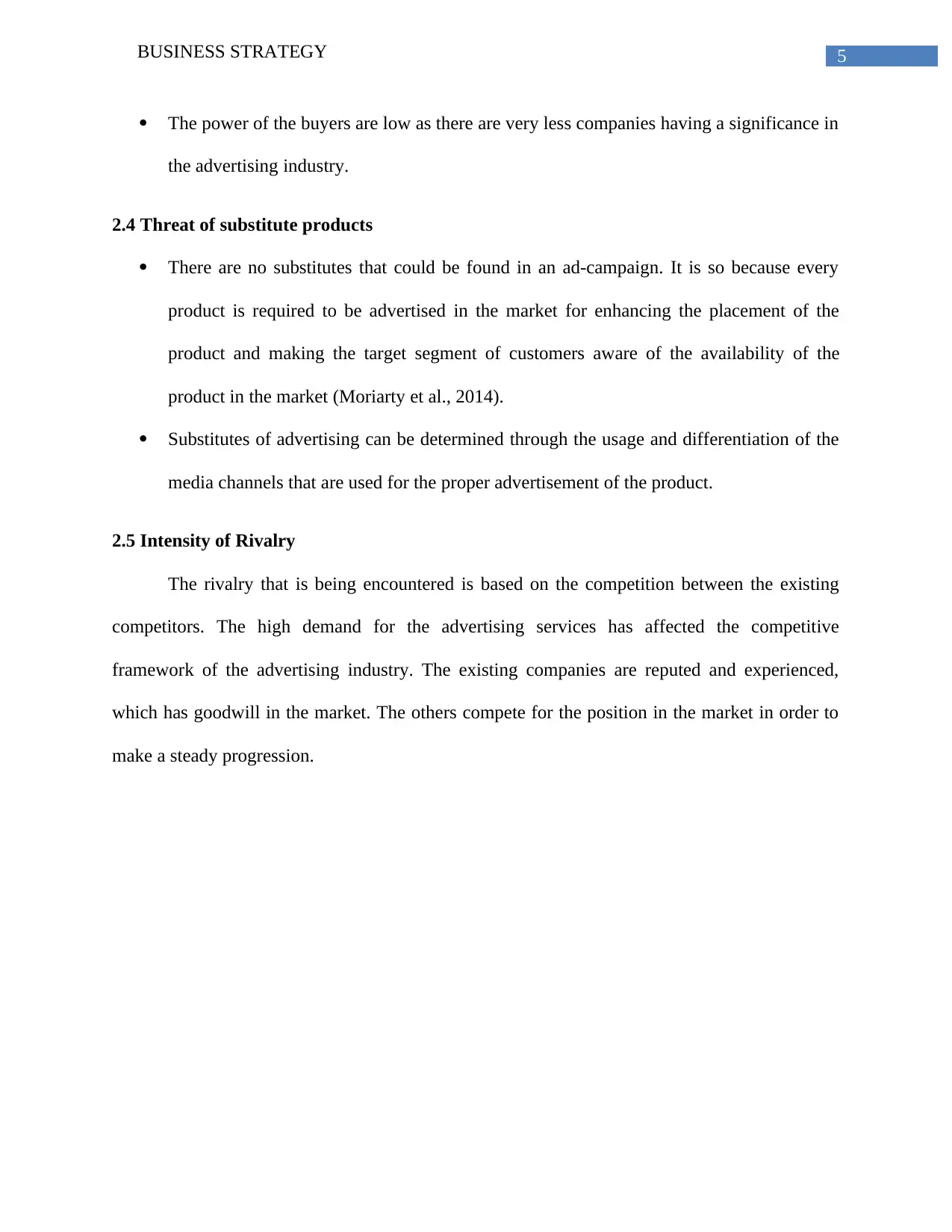
5BUSINESS STRATEGY
The power of the buyers are low as there are very less companies having a significance in
the advertising industry.
2.4 Threat of substitute products
There are no substitutes that could be found in an ad-campaign. It is so because every
product is required to be advertised in the market for enhancing the placement of the
product and making the target segment of customers aware of the availability of the
product in the market (Moriarty et al., 2014).
Substitutes of advertising can be determined through the usage and differentiation of the
media channels that are used for the proper advertisement of the product.
2.5 Intensity of Rivalry
The rivalry that is being encountered is based on the competition between the existing
competitors. The high demand for the advertising services has affected the competitive
framework of the advertising industry. The existing companies are reputed and experienced,
which has goodwill in the market. The others compete for the position in the market in order to
make a steady progression.
The power of the buyers are low as there are very less companies having a significance in
the advertising industry.
2.4 Threat of substitute products
There are no substitutes that could be found in an ad-campaign. It is so because every
product is required to be advertised in the market for enhancing the placement of the
product and making the target segment of customers aware of the availability of the
product in the market (Moriarty et al., 2014).
Substitutes of advertising can be determined through the usage and differentiation of the
media channels that are used for the proper advertisement of the product.
2.5 Intensity of Rivalry
The rivalry that is being encountered is based on the competition between the existing
competitors. The high demand for the advertising services has affected the competitive
framework of the advertising industry. The existing companies are reputed and experienced,
which has goodwill in the market. The others compete for the position in the market in order to
make a steady progression.
⊘ This is a preview!⊘
Do you want full access?
Subscribe today to unlock all pages.

Trusted by 1+ million students worldwide
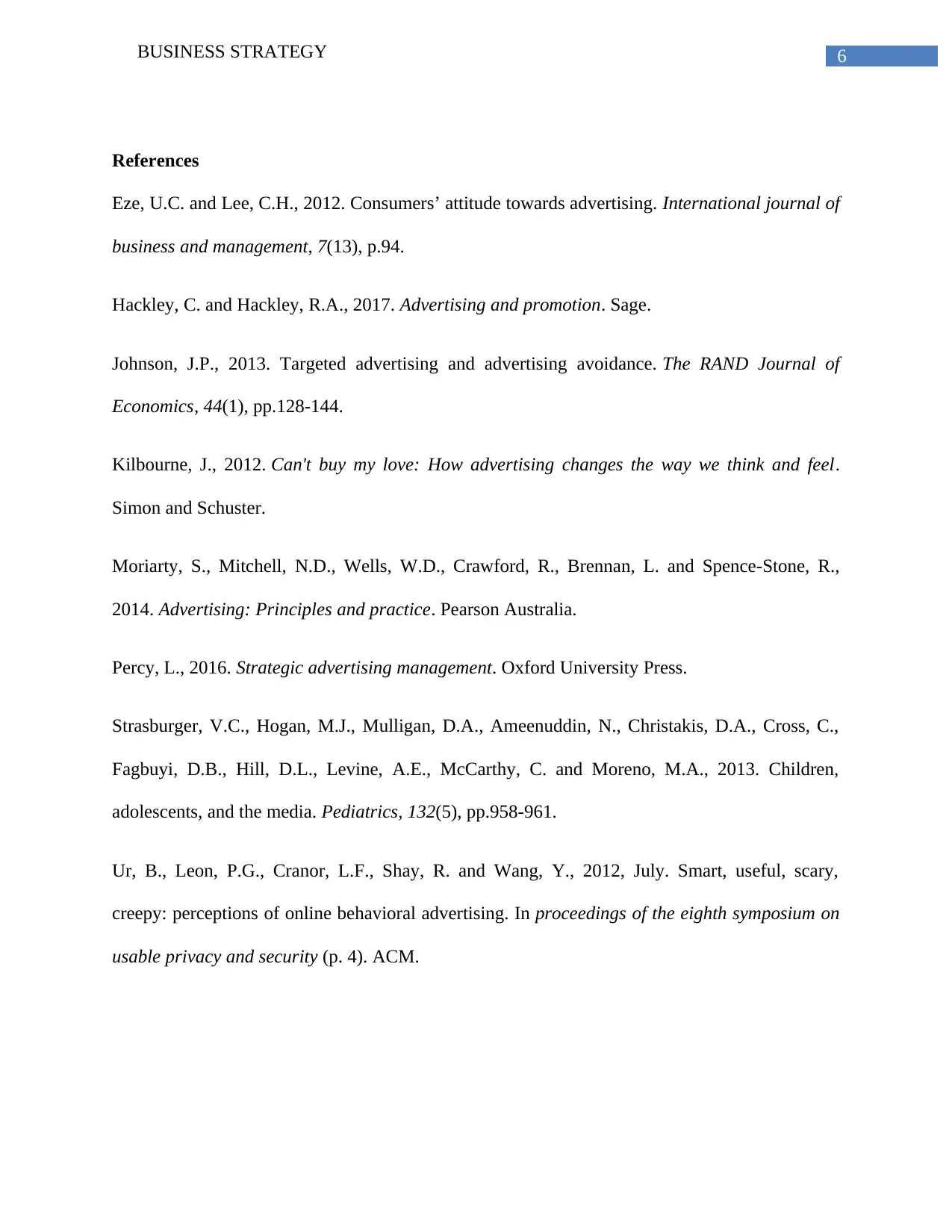
6BUSINESS STRATEGY
References
Eze, U.C. and Lee, C.H., 2012. Consumers’ attitude towards advertising. International journal of
business and management, 7(13), p.94.
Hackley, C. and Hackley, R.A., 2017. Advertising and promotion. Sage.
Johnson, J.P., 2013. Targeted advertising and advertising avoidance. The RAND Journal of
Economics, 44(1), pp.128-144.
Kilbourne, J., 2012. Can't buy my love: How advertising changes the way we think and feel.
Simon and Schuster.
Moriarty, S., Mitchell, N.D., Wells, W.D., Crawford, R., Brennan, L. and Spence-Stone, R.,
2014. Advertising: Principles and practice. Pearson Australia.
Percy, L., 2016. Strategic advertising management. Oxford University Press.
Strasburger, V.C., Hogan, M.J., Mulligan, D.A., Ameenuddin, N., Christakis, D.A., Cross, C.,
Fagbuyi, D.B., Hill, D.L., Levine, A.E., McCarthy, C. and Moreno, M.A., 2013. Children,
adolescents, and the media. Pediatrics, 132(5), pp.958-961.
Ur, B., Leon, P.G., Cranor, L.F., Shay, R. and Wang, Y., 2012, July. Smart, useful, scary,
creepy: perceptions of online behavioral advertising. In proceedings of the eighth symposium on
usable privacy and security (p. 4). ACM.
References
Eze, U.C. and Lee, C.H., 2012. Consumers’ attitude towards advertising. International journal of
business and management, 7(13), p.94.
Hackley, C. and Hackley, R.A., 2017. Advertising and promotion. Sage.
Johnson, J.P., 2013. Targeted advertising and advertising avoidance. The RAND Journal of
Economics, 44(1), pp.128-144.
Kilbourne, J., 2012. Can't buy my love: How advertising changes the way we think and feel.
Simon and Schuster.
Moriarty, S., Mitchell, N.D., Wells, W.D., Crawford, R., Brennan, L. and Spence-Stone, R.,
2014. Advertising: Principles and practice. Pearson Australia.
Percy, L., 2016. Strategic advertising management. Oxford University Press.
Strasburger, V.C., Hogan, M.J., Mulligan, D.A., Ameenuddin, N., Christakis, D.A., Cross, C.,
Fagbuyi, D.B., Hill, D.L., Levine, A.E., McCarthy, C. and Moreno, M.A., 2013. Children,
adolescents, and the media. Pediatrics, 132(5), pp.958-961.
Ur, B., Leon, P.G., Cranor, L.F., Shay, R. and Wang, Y., 2012, July. Smart, useful, scary,
creepy: perceptions of online behavioral advertising. In proceedings of the eighth symposium on
usable privacy and security (p. 4). ACM.
1 out of 7
Related Documents
Your All-in-One AI-Powered Toolkit for Academic Success.
+13062052269
info@desklib.com
Available 24*7 on WhatsApp / Email
![[object Object]](/_next/static/media/star-bottom.7253800d.svg)
Unlock your academic potential
Copyright © 2020–2025 A2Z Services. All Rights Reserved. Developed and managed by ZUCOL.




